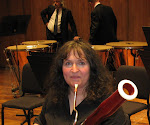The Columbus Symphony has performed a number of Baroque works recently with our Music Director Jean-Marie Zeitouni in which we did actually follow Baroque performance practice. (If you'd like to hear an example, InstantEncore is streaming our Best of Baroque concert.) But I haven't had enough experience in the Baroque realm to be able to state that I'm comfortable with it yet.
Earlier this month I had the opportunity to perform with another orchestra. One of the featured works was the Vivaldi Concerto for Flute, Oboe and Bassoon "La Tempesta di Mare" RV 570. The first movement is featured in this video by La Orquesta Sinfonica "Kronos":
None of the recordings I found of this work had much, if any, ornamentation going on in the solo bassoon part, so at first I was planning to just play the printed notes. But I have always been fascinated by Baroque ornamentation. When I closely examined the bassoon part it appeared as though someone had penciled in some ornamentation which had been erased. At first I ignored it, but eventually I became obsessed with the notion of adding ornamentation to my part.
I found a couple of YouTube videos of the piece which were pitched at A=440, and I played along. I really liked adding ornamentation, and practiced doing so. At first I used the faint traces of ornamentation which had been erased from my part, and using those markings as examples, I came up with some fairly elaborate ideas. There wasn't enough room on the part to write out those elaborate ideas, so I wasn't sure what to do? Should I write out a whole new part? Should I even be trying to plan the ornaments before I knew the tempos? Or should I just "wing it"?
And how exactly does one "wing it" anyway? How do we learn how to improvise ornamentation? The only way I know of is to listen to examples. When I was a student at Eastman I spent many an hour in the music listening library learning how to be a musician. I was mesmerized by a recording of oboist Leon Goosens playing the Bach Arioso BVW 1056. It included ornamentation which is forever embedded in my brain.
It's easy to find examples of Baroque ornamentation on YouTube. Here's a gorgeous example by German oboe virtuoso Burkhard Glaetzner:
On the day of the first rehearsal of the Vivaldi Concerto for Flute, Oboe and Bassoon "La Tempesta di Mare" I had still not figured out what I was going to do......I wanted to use ornamentation, but fully expected that the conductor would put the keibash on that. After all, I have never before used ornamentation in the orchestra. I had other things to worry about anyway, such as whether I would double-tongue or single-tongue the many consecutive 16ths.
During the initial read-through of the first movement, I was a complete and utter coward. I played it straight, without a single added note. Luckily for me, we went back and read it again. This time emboldened, I found myself adding notes and flourishes here and there which seemed to fit, kind of playing it by ear.
When we finished that run-through, I braced myself for the conductor to ask what on earth was going on with the bassoon. To my complete surprise, he exclaimed that he loved the ornamentation in the bassoon!
The tempo was faster during the performance, which is one of the reasons why it's so exciting to be an orchestral musician. (I mean that! I love the thrill of having to adjust at the last minute as the conductor and musicians find themselves caught up in the moment.) This meant that I had to switch to double-tonguing and it also meant that the ornamentation was different from what I had in mind. It was a thrilling performance, the type that reminds us of why we chose to be musicians.
.





